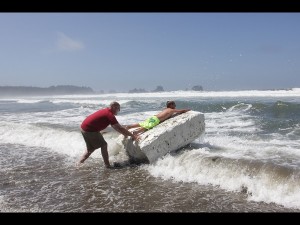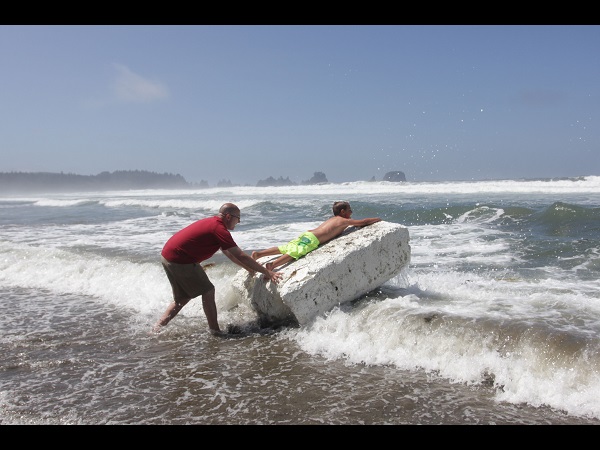
SHI SHI BEACH, Washington — First there’s a drive through windy seaside and tree-lined roads. Then there’s a peek at the farthest northwest point in the lower 48 states. Finally, after a 2-mile (3.2-kilometer) hike along a wilderness trail with a descent down a 150-foot (46-meter) bluff, the reward is one of the most pristine spots on the coastline of Olympic National Park: Shi Shi Beach.
Curved conifers stand behind the beach as a testament to wind power. Deer wander down the bluffs to nip at leaves. Eagles perch atop bare pine trees. Driftwood washed ashore by Pacific waves lines the sand banks. In all, the 2.3-mile (3.7-kilometer) beach located at the northern end is an unpolished gem, far less visited than other park beaches with easier access.
“I like it because you see the expanse and you can be alone,” said Tom Ammann, who’s been hiking this coastal area for eight years, mostly in winter and fall. “I think that’s one of the nicer places on the planet, actually.”
Farther along the beach, one of Shi Shi’s most striking features is Point of Arches, a collection of rock formations known as sea stacks standing tall above the surf. Natural arches and caves decorate this part of the coast and provide exploring grounds for sea creatures once low tide comes in. Ambitious hikers can continue down the coastline, either on the beach or through the forest using marked trails.
“We go out there in that solitude with open space,” Ammann said. “You just sit there and you look — something that’s kind of lost in this culture.”
But while your cellphone won’t work here, the modern world intrudes in other ways. The beach is sprinkled with debris washed up by ocean currents — including items you don’t normally find in everyday litter, like drums, child-sized blocks of Styrofoam, ropes and boots. Some of it comes across the Pacific from Asia, including debris from the Japanese tsunami, which park spokeswoman Rainey McKenna said is expected to continue to wash up for a number of years.
Camping is allowed on the beach, along with campfires as long as driftwood is used to build the fire. Park rules require that all food and garbage be stored in bear-proof canisters, although a park ranger said the most commonly seen animals are raccoons and skunks. Indeed, on our second night, a skunk was attracted to the smell of our roasting salami, scuttling about the campsite before disappearing back into the brush.
All supplies must be carried in — you won’t find concessions here — and all garbage must be carried out. There are three pit toilets behind the beach but they don’t provide much privacy.
Shi Shi (pronounced shy shy) was one of the last additions to Olympic National Park in 1976.
Public access to the beach was created only after a protracted struggle involving developers, land owners and squatters, according to the Washington Trails Association. And the trail to the beach can only be reached after driving through the Makah Indian Reservation, which visitors must pay to enter, and where they must also pay to park their cars. Shi Shi is a Makah term for surf or smelt beach — a reference to the small silvery fish that are still found on the coast.
“The only thing grander than Shi Shi’s natural beauty is its resilience in the face of forces that would have prohibited us from enjoying and admiring this national treasure,” a guide from the trails association states.
While natural beauty is the main reason to come here, Shi Shi does offer other attractions. The waves are big enough to draw wetsuit-clad surfers. A few kids swam freely in the waves despite water temperatures that are typically in the low 50s in summer, while young campers climbed a bluff after playing Frisbee.
On the weekend I visited, the fog disappeared early afternoon and gave way to searing sunshine. It got so hot it felt like I was on some tropical beach, instead of just a few hours from home and blissfully disconnected. Manuel Valdes
If You Go:
SHI SHI BEACH: Located 8.5 miles (13.6 kilometers) south of Neah Bay, Wash., about 4.5 hours northwest of Seattle; https://www.nps.gov/olym/planyourvisit/shi-shi-beach-olympic-wilderness.htm .
GETTING THERE: Shi Shi beach is reached via Highway 112, which snakes along Washington’s northwest border on the Olympic Peninsula and the Strait of Juan De Fuca across from Canada. Visitors must drive through the Makah Indian Reservation to get to Shi Shi and overnight parking is only available at private lots on the reservation for about $10. Visitors must also purchase a pass from the tribe, $10 per vehicle, available at several locations in Neah Bay, including the reservation museum and minimart. A $5 per person National Parks pass must also be purchased, and for overnight stays, posted on tents.
WASHINGTON TRAILS ASSOCIATION: https://bit.ly/15ekSpC
BEAR CANISTERS: These portable, animal-resistant food storage containers can be borrowed from the park’s Wilderness Information Center and some ranger stations, with a suggested $3 donation, or purchased at stores that sell camping supplies.









































